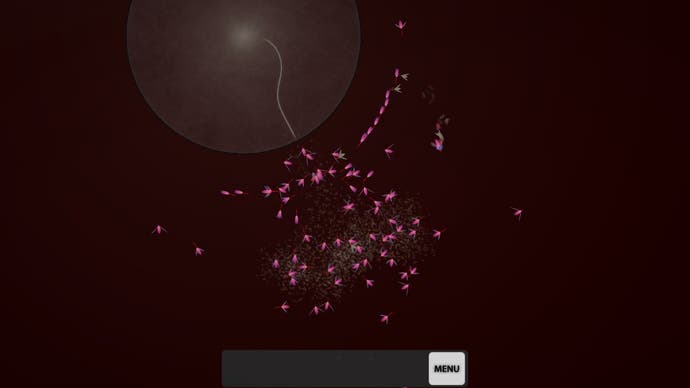Eufloria
Sow and sow.
The way your units attack asteroids can be frustrating. Ideally, you'd want all your seedlings to arrive at a heavily fortified planet at the same time: overwhelm the mines, destroy a tree, and infest the asteroid's core. But because your seeds may have been produced by different asteroids with different speeds, and will leave from wherever they were in their orbit, they can form a tunnel of easily picked off loners. This is only really noticeable on despatches from larger asteroids, but it's another factor that encourages you to simply wait and grow your army.
A second, crippling weakness - and one that I discovered by rubbing my eyes, and going to make a cup of tea - was that going to another room for a few minutes solves all your tactical problems. Each planet has a seed cap, after which it'll stop producing new ones. But there's no meaningful limit to how many you can move to an asteroid (I started getting rejected orders at 687 - in a rare moment of poor communication, the game didn't explicitly tell me it was failing, the orders were simply not obeyed).
In the first 20 levels, at least, the steady production of your Dyson trees and the lack of thoughtful hostility from enemy empires mean you can play a couple of rounds of Civ and come back to Eufloria for an easy seed-rush win. The simplest and almost inevitably successful tactic is to wait and overwhelm. It's so simple to do that any other tactic is only employed to make yourself feel less cheap.

There are exceptions: in Hide and Seek, the idea is to avoid direct conflict. I came back to the PC, with my thirteenth cup of tea, to find my Dyson trees subdued with enemy mines, and no surviving seedlings. I was being kept alive purely for the entertainment of the turquoise empire, who still couldn't understand why I butchered them so senselessly in level three. In level 23, Collision Course - and some of the Skirmish levels - you'll find yourself beseiged and fighting a war on multiple fronts. At these moments, suddenly it matters how you've distributed your armies. Suddenly, waiting isn't an option. Respect becomes finally due: but this just doesn't happen enough. Even in Dark Matter mode, an even prettier version where the AI is supposedly tougher, the mental challenge is rarely more than extreme patience.
It says something about Eufloria that I've written 1500 words about it, and the only thing stopping my writing another 1500 is consideration for you, the reader. For a game with so few rules, it manages to generate a real desire to talk about every decision made by the developers.
Let's go back to the King of France. I wouldn't want anyone to get the impression that I was suggesting Eufloria is a dog turd, because it's a beautiful, thoughtful curiosity. But somewhere in getting at the essence of strategy gaming, Eufloria has become a sketch, a distraction, a showcase, and a toy: it's an experience that you'll enjoy, rather than a coherent and satisfying game. And how do you give that a score? Those who'll love it - and there'll be a vocal many who do - will be fuming at the 4 I want to give the game. But those who despise imagined pretentiousness will queue up to call me a pseud bell-end if I give it a meaningless pat on the head with a 7. The sad answer is this.
Eufloria is available to buy from the developer's website.









